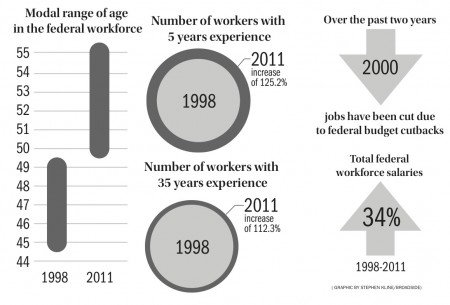Characteristics, including number of women in the workplace, also changing
As a major employer of residents of the Metropolitan Washington Area, the federal workplace is often seen as a defining characteristic of this area. This federal workplace, however, is changing. Joanna Biernacka- Lievestro, a graduate student research assistant at the Center for Regional Analysis, has found that the federal workplace is decreasing after 12 years of gains.
“I think this particular topic is pretty relevant to the current economy in the region,” Biernacka-Lievestro said. “I thought it would be interesting to see how the federal workplace is changing, along with the characteristics of this federal workplace.”
Lower government service (GS) grade-level jobs decreased, while higher level managerial positions increased. The federal workplace also faces an age problem.
“What we have learned from the area is that one of the research findings is that the workforce is aging,” Biernacka-Lievestro said. “We have the issue of aging in the federal workplace, and what is going to happen when these people retire.”
Biernacka-Lievestro has also found other characteristics changing within the federal workforce. Between 1998 to 2011, the total number of salaries paid to the federal workplace increased by 34.1 percent. According to the research, the proportion of females in higher level positions has passed that of males.
“Females are moving up, especially in the pay level,” Biernacka-Lievestro said. “They are getting managerial positions and making more money than they did in the past.”
Director of the Center for Regional Analysis Stephen Fuller notes that for young adults looking for employment, the federal workforce may present opportunity.
“It is an excellent time to enter the federal workforce as all agencies are experiencing increasing retirements of older workers leaving a wide range of opportunity available for new workers. The salary structure is comparable to the private sector and younger workers often find themselves in positions of responsibility far greater for their age and years of experience than they would in the private sector.”
The research shows that within the Washington DC Metropolitan area, the years 1998 to 2011 saw the average age grouping move from ages 45-49 to ages 50-54.
“I suppose it could mean opportunity. The large volume of retiring federal workforce can trigger the process of promotions within the federal government, opening the lower-level positions to be filled by young people,” Biernacka-Lievestro said.
The federal workplace often adds jobs when the economy is bad and decreases in jobs when the situation is recovered, following a cycle. “The biggest factor is the reduction in federal spending that was mandated in the Budget Control Act of 2011, but it is also the normal cycle- government tends to add jobs when the economy is bad or there is a war. Well, we have had both of those over the past ten years,” Fuller said.
When you live in D.C., people often assume that you work for the federal government. But, in fact, the federal workplace is decreasing, and more people are working for the private sector.
Joanna Biernacka-Lievestro
According to Fuller, 22,000 federal jobs will be lost over the next five years, which adds up to 31,000 jobs of our peak.
“But we added 40,000 jobs over the last decade. So, it isn’t like the federal jobs are disappearing- they are just evening out, which they tend to do,” Fuller said.
Not only is the federal workplace aging, but more people than before are now working in private sector jobs as opposed to the federal workplace. The research suggests that the private sector is growing, although Biernacka-Lievestro cannot be certain, as the data concerning where people begin working after leaving the federal workplace cannot be tracked.
“When you live in D.C., people often assume that you work for the federal government,” Biernacka-Lievestro said. “But, in fact, the federal workplace is decreasing, and more people are working for the private sector.”
Within the federal workplace, Biernacka- Lievestro says that people who have worked in the federal workplace for less than five years are being hired, with the researching showing that these workers with less than 5 years of experience increased by 125.2 percent between 1998-2011. Because the workplace is aging and the number of older workers has increased, Biernacka-Livestro believes that these new hires are older than 55.
According to Fuller, federal government workers who retired tend to have higher incomes than newer workers. This led the federal payroll to decrease for the first time since 1996. This trend is also mimicked in the private sector.
“One can imagine there will be an decrease in demands for Audis and Mercedes and an increase in demand for lower priced cars or smaller apartments or houses or more renting units than owner units,” Fuller said.







Comments